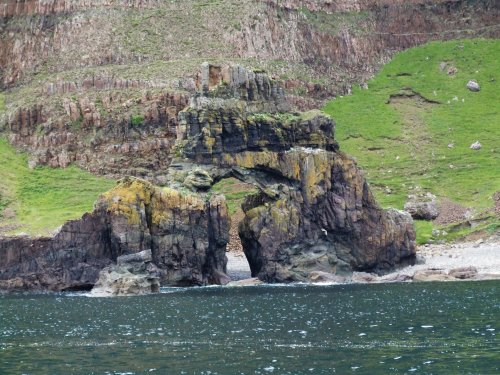Carsaig Arches on:
[Wikipedia]
[Google]
[Amazon]
 Carsaig Arches are
Carsaig Arches are
File:Carsaig Arches.JPG
File:Lava Flows at Carsaig Arches - geograph.org.uk - 652960.jpg
File:Carsaig Arches - geograph.org.uk - 14379.jpg
 Carsaig Arches are
Carsaig Arches are natural arch
A natural arch, natural bridge, or (less commonly) rock arch is a natural landform where an arch has formed with an opening underneath. Natural arches commonly form where inland cliffs, Cliffed coast, coastal cliffs, Fin (geology), fins or Stack ...
cliff formations on the Ross of Mull
The Ross of Mull (Scottish Gaelic: ''An Ros Mhuileach'') is the largest peninsula of the Isle of Mull, about long, and makes up the south-western part of the island. It is bounded to the north by Loch Scridain and to the south by the Firth of ...
in the south of the Isle of Mull
The Isle of Mull or simply Mull ( ) is the second-largest island of the Inner Hebrides (after Skye) and lies off the west coast of Scotland in the Council areas of Scotland, council area of Argyll and Bute.
Covering , Mull is the fourth-lar ...
, on the west coast of Scotland. They are situated below Malcolm's Point, at the base of the Rudha Fhaoilean cliffs.
To the east are Carsaig Bay
Carsaig Bay is a cove on the Ross of Mull in the south of the Isle of Mull, off the west coast of Scotland. It is situated eastward of Rudha Fhaoilean, and south of Pennyghael.
The bay is small and is surrounded by high, precipitous hills. It ...
, and Eas na Dabhaich.
The coastal cliff formations are the result of the erosion of oolitic rock beds located to the west of the entrance to Loch Bay. Reached via a road from the Carsaig Pier, the track is strewn with volcanic rocks and boulders and involves about 4 miles of walking to reach it.
The first arch is visible at the end of the trek while descending from the ridge and looks as if it is opening into the sea and the second one is hidden. The openings created by wave action have been likened to cave entrances that "lead to another planet." They are most easily approached during low tides. Of the two arches seen below the cliff, one has been described as being like a railway tunnel "deep and dark" and the other rises high and overlain by debris which is conjectured as being of an earlier collapsed arch.
One of the formations is a pyramidal mass of rock, perforated through the middle by an unusually shaped arch (called the "keyhole"), and surmounted by the solitary shaft of a basaltic pillar. Another arch ("tunnel") is massive, with columnar basalts appearing to hang from the top.) It is in height over a length of with a width of . Wild goats, golden eagle
The golden eagle (''Aquila chrysaetos'') is a bird of prey living in the Northern Hemisphere. It is the most widely distributed species of eagle. Like all eagles, it belongs to the family Accipitridae. They are one of the best-known bird of pr ...
s, breeding fulmars, and kittiwakes frequent the area.
Gallery
References
{{Mull Landforms of the Isle of Mull Natural arches of Scotland